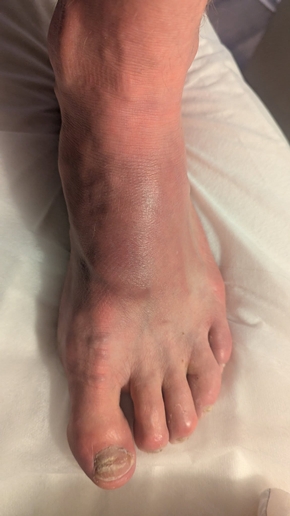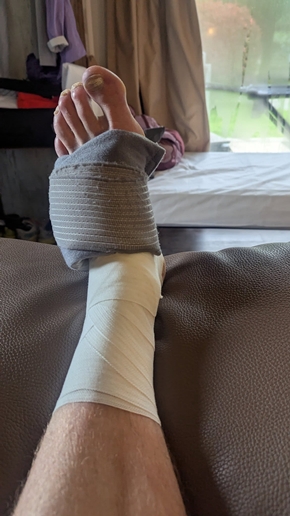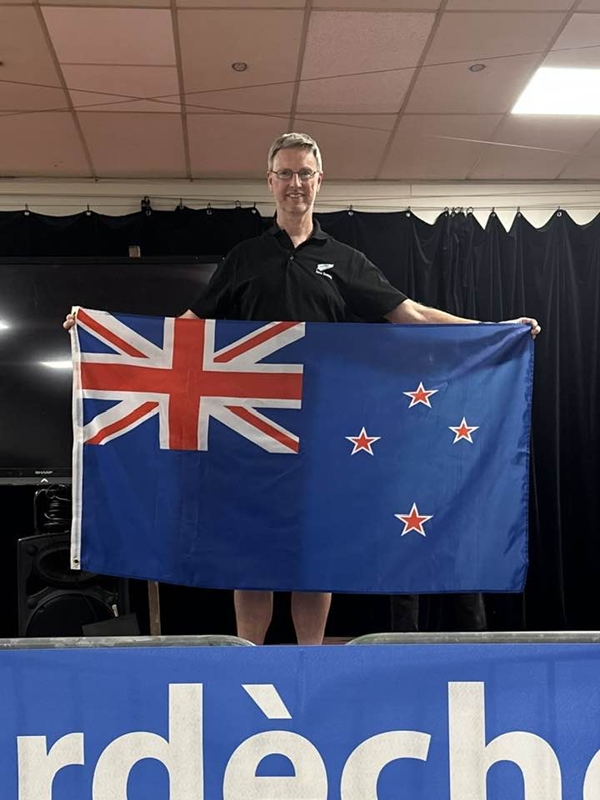
This is the first (and hopefully last) time that I am writing my race report before the race has finished!
Why am I writing my race report now?
Well, for me the race finished when I woke from my morning sleep 42 hours into the race to find that I couldn’t put my left foot on the ground without immense pain. I knew immediately that my race was over.
The problem actually started in the first few hours of the race. At the end of the first hour I stopped for a minute to loosen my left shoe. I had been feeling a bit of pain across the top of my foot and thought that perhaps my shoe was tied too tight.
At three hours I took a longer break and inserted a sponge into the top of the shoe – in between the foot and the tongue/laces to reduce the pressure from the lacing of the shoe over the painful area of the foot. I always take a sponge to long races in case I need it and I’ve had to do similar before – at the end of this same race in 2022 for example, when I had a similar pain in both feet during the last few hours.
And then, at 11 hours I changed my shoes, sticking with my preferred Brooks Adrenaline but changing from a newish pair to an older pair, and changing from my old orthotics to my new orthotics – hoping to find something that would resolve the problem.
I have been struggling with minor injuries all year, mainly in my right foot and Achillies, and had brought four pair of shoes, two pair of orthotics (both the same specs but I hadn’t had the new ones for long so I trusted the old ones more), and a set of normal shoe insoles so that I could experiment if my right foot played up. I never expected it would be my left foot that caused issues.
The race:
Going into the race I felt undertrained compared to previous years – My total training distance was 300 to 450 kilometres less in my 16 week build-up compared to each of the last three years, and I had only completed two 100 mile training weeks compared to the nine I had planned (I have never actually managed all nine. The last three years were 6, 7 and 5 100 mile weeks during the build-up).
Outwardly I was positive about my chances and inwardly I was semi-convinced that I would still do well. If you start any race with a negative attitude, well you may as well not turn up. So I told people I was chasing the world record (786km) and convinced myself that that was possible.
My main competitor in the race, in my mind anyway, was Maxime Laneau. Maxime was attempting his first six day race but is the current French 24 hour champion and had previously walked 420+ kilometres in 72 hours. By comparison, my best 72 hour distance is the 382km I walked in the first half of this race in 2023.
To everyone’s surprise though, the early leader was Argentina’s Maria jose Verdaguer. She was walking like a women possessed, and I think she had lapped all other walkers before 50km!
There were 26 starters in the walker’s race and 115 runners – the biggest field this race has seen since before the pandemic. The reason for this was that it is also the GOMU six-day world championship.
The 6 Jours de France has always attracted the world’s best six-day walkers because it is the only six-day race with race-walking judges but, being the world championship, the calibre of the runners was also exceptional and even if I had a great race, there was no chance of me achieving a top 5 overall placing like in the previous three years. At the time of writing this, the race still has over 18 hours to go, but it looks like both the men’ and women’s six-day running world records will be broken before the race finishes tomorrow.
The weather during the first four hours was hot! Especially for someone coming from London who hasn’t seen summer yet this year and still needs to wear a jacket when training.
Hot that is, until it rained.

There was no rain in the forecast (for day 1) but at 4pm the heavens opened and just as happened last year, within a short period of time there was major flooding at the bottom of the course and minor flooding at the top of the out-and-back section.
From a temperature point of view, the cooling effect of the rain was nice but to avoid walking through ankle-deep water at the bottom of the course athletes were being forced to take wider and wider detours on the grass come mud, and as darkness fell this was becoming dangerous.
Don’t get me wrong. I love this race, and this venue. But after we experienced the same flooding last year, and with rain forecast for later in the race, the organisers should have been prepared. They had a half-hearted attempt to sweep the water away in between showers, but when the rain returned they gave up on that and late on night 1 one of the runners took 30+ minutes out of his race to do what the organisers should have been doing – successfully swept the water away from the track.
At about the same time the organisers finally turned up with some sort of vacuum device to remove the remaining water from the bottom of the course as well as the other puddles on the track, and the following day they covered the mud (used to be grass) beside the flood-prone area at the bottom of the course with astroturf before the next forecast rain (which didn’t come, but there is rain in the weather forecast for the last day of the race).
In my view, they should have had both the water vacuum and the astroturf available and ready before the race started given that there was a high chance of rain (and flooding) during the race. Given that this race was a world championship, I would have thought that would be a minimum expectation by both GOMU and all the competitors.
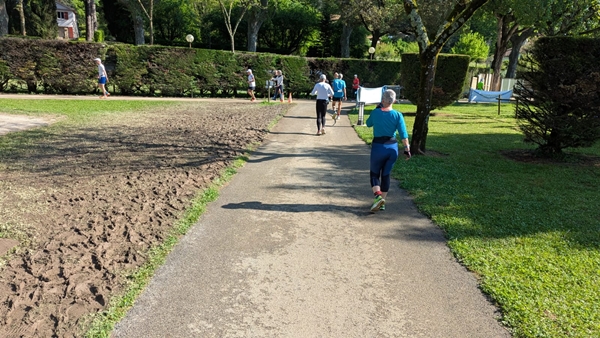
Anyway, back to the race. At some time during the first evening of the race Maria must have taken a break. At around 9 hours or so I checked the scoreboard and saw that Maxime was leading, Dominique Delange was second and I was in third place, with Dominque, Maria and myself all on the same lap – one lap behind Maxime.
As is often the case in multi-day races, the lead changes constantly when athletes take their sleep breaks and when I stopped for my first sleep break at 5am (17 hours), I had a 5km lead over Dominque who was 7km ahead of Maxime.
Unlike previous years, my strategy this year was to have a sleep of between 30 and 90 minutes just before daylight each morning starting from the beginning of the race. In previous years I had always aimed to get past 100 miles before my first sleep and then really struggled during day 2. This year I wanted to try getting an early sleep and see if that helped me.
I was in the cabin for about 75 minutes, sleeping for around 30-40 minutes. When I woke I changed my shoes again. This time I changed to my Hokas which I relaced so that the laces didn’t go over the painful part of my foot.
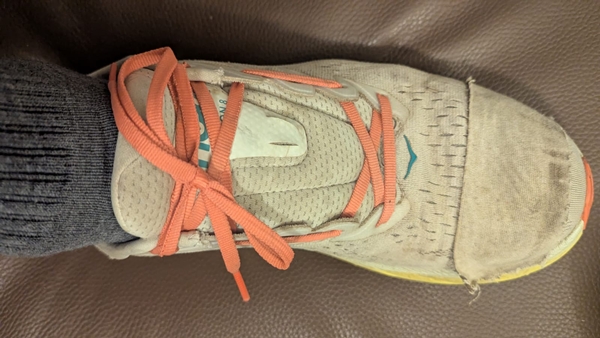
When I resumed the race I was in second place. Dominique was 3km ahead of me and Maxim was 3km behind.
Walking in wet shoes the previous night had messed up my feet a little and I stopped just before 24 hours to urgently drain a painful blister, but the good news was that changing/relacing my shoes seemed to have worked and I was confident that my foot problem was now resolved.
At 24 hours my total distance was 146km – 20km behind each of the last two years. Not all of that deficit was due to my new sleep strategy. I was walking slower than in the last two years.
Even with my planned morning sleep, my original race plan put me at around 160km, give or take, at 24 hours. Whilst I was down on that schedule, if day 2 went to plan I would still get into the high 270’s by 48 hours, so I was relatively happy with progress.
I eventually passed 100 miles (160.9km) in 26 hours 23 minutes – my 48th walk of 100 miles or more.
I stopped for a 30-minute sleep at around 6pm and another at 11pm, and when I resumed walking, I was in second place with 201km. Maxime was leading with 208km and Dominique was 1km behind me. There was a further 15km gap back to 4th and 5th places.
It turned out that both Maxime and Dominique were asleep, and I soon took the lead for a second time.
It was hard going though. My lap times were much slower than they should be this early in the race – averaging 14 minutes when they should have been under 12 – and it was getting cold.
At 4:30am I decided to go in early for my 5am sleep. Not because I was tired, but because I was extremely cold. I wanted to get inside my sleeping bag, inside our warm cabin, and warm up a bit.
What I didn’t know was that was going to be the end of my race!
As I always do before a long break, I took a photo of the scoreboard so that I could then check how far I had dropped down the leaderboard (or our much the gap had closed) during my break. I had completed 226km, 3km more than Maxime, and 13km more than Daniel Duboscq (one of the seven of us who have walked 700km or further in a six-day race – but that was ten years ago when he set the M60-64 world record). I was happy with my overall position, and I was also just outside the top 20 overall.
About an hour after going to bed I woke up to go to the toilet, put my foot on the ground, and realised that there was no way I would be resuming the race. My foot was in agony!
The toilet is next to my bed, so I got to the toilet, got back into bed and went back to sleep. Sarah (our operations manager – the best support crew I could ask for) was due to wake me at 6:30 so I decided to wait and see if things felt better then. They didn’t.
I had a shower and breakfast and then hobbled over to the medical tent to wait for them to open at 8am. The doctor thought that the injury might be a stress fracture and suggested that I go to the hospital for an x-ray. He also said that it could be an inflamed tendon, so I decided to go with that diagnosis.
I couldn’t see any benefit in getting an x-ray immediately. Firstly, stress fractures often don’t show up in x-rays immediately and secondly, I couldn’t do anything about it if it was.
If it was an inflamed tendon, then rest, ice, compression and elevation (RICE) would help, and I spent the day doing just that.
|
|
|
The following morning the foot felt a lot better and after checking with the race doctor, I decided to resume the race. I hadn’t come here to watch a race. I had come here to participate.
Mount to Coast, the sponsors of GOMU kindly gave me a pair of their shoes and I thought why not try something completely different and see what happens. I have nothing to lose.
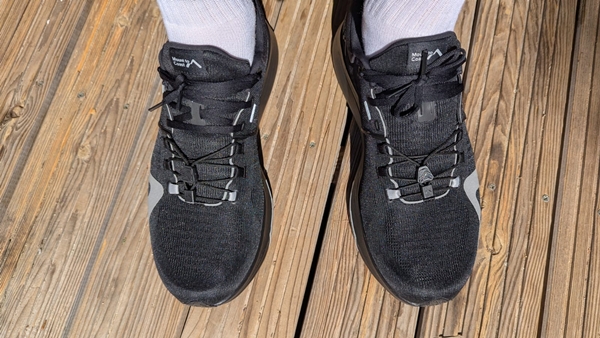
I walked 5km in the Mount to Coast R1’s and then rested an hour. My foot was OK’ish, but I decided to try the fourth pair of shoes that I had bought with me – my Altra Paradigm’s. I don’t really like these shoes due to their low (or maybe zero) drop. But they have a very wide toe box, and I thought that with the same method of lacing that I had used in my other shoes, that might be worth a try.
But they didn’t really help either, so I decided to try the R1’s again, but without my orthotics. My orthotics lift my foot up in the shoe and whilst I need them for arch support, I thought that if I wear the shoes with their normal insoles, that would provide more room for my foot and maybe I would be OK.
I walked 3 ½ hours at 12 ½ minutes average lap pace and felt pretty good.
At 7pm I stopped for dinner and a two-hour sleep. The test would be how my foot felt when I woke up, and it was fine. I had a second dinner and headed back on to the track, walking for a full eight hours before my next break.
At 7am, I was on 300km and my legs were feeling tired but other than that I felt OK. I took a short break for Sarah to give my legs a massage, but I wasn’t tired so I headed back on to the track with the goal of getting through to 12 noon, the end of day 4 before my next sleep.
I knew that I was no longer competitive, but I thought that with two full days to go, 500km would be possible. 500.4km was my worst previous six-day result back in 2017 and I was now on 326km – having completed 100km since restarting.
I took my shoes off and immediately realised that my foot problem was back, and my race was now well and truly over.
It’s now over 24 hours since I stopped. I slept for the majority of the first 20 of those hours and have spent this afternoon sitting on the deck outside of our cabin watching the runners and walkers go by, keeping my foot elevated. There is no swelling now so the doctor has said that ice isn’t so important, and the foot doesn’t actually hurt much at all.
Disappointed?
It isn’t so much the fact that my race didn’t go well that upsets me. It’s all the training, the early morning starts, the sacrifice, and the money that goes into being in top physical and mental condition for a race like this. It’s not like a 5k, or even a marathon, where if something goes wrong you can just do another one.
I know I wasn’t in top physical condition this year. I had struggled with injury since the beginning of the year and because of that I wasn’t as mentally prepared either. I definitely wasn’t as mentally focussed in my build-up as in previous years.
But at the same time, I’ve completed six previous six-day races without any serious injury. It had to happen one day.
The future:
Going into this race I was seriously thinking that this might be my last time racing a six-day at this particular event. I don’t think I want to train through another winter, and if I don’t start my high-mileage training in early January, I won’t be in the condition I need to be at the end of April.
I’m till thinking that that might be the case. But I can’t be 100% certain of that. I will miss my annual trip to this race and all the friendships I have here. Especially our team – Kathy, who is still out there walking though to the finish, and Sarah, the most amazing support person, who has been with us for my last four (including this one) six-day races.
But there are plenty of other six-day races at better times of the year from a training perspective. And with that in mind, I will be competing in the first ever six-day race to be held in New Zealand later this year (starting 29th September).
I’ll decide what’s next after that.
